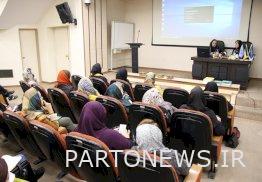The role of cultural heritage, art and history in culture building for children was investigated

According to the report of Arya Heritage, quoted from the public relations of the Cultural Heritage and Tourism Research Institute, Ardashir Hashosi, a university lecturer, researcher and instructor in the field of children’s art, on December 23, 1401, discussed the motifs of historical works for the art and creative visualization lesson for children, and the purpose of addressing He considered this issue as answering the question whether artistic activities can be a suitable platform for children and teenagers to get acquainted with cultural heritage, and if so, how?
He clarified: In order to answer this question, we must first provide a definition of cultural heritage and culture, and then take a look at the category of children’s art.
Popek Azimpour, a professor of drama and a member of Tehran University’s academic staff, also spoke about the role of ritual shows in creating culture for children and said: Rituals have always flowed in societies in unifying and balancing for common human goals, and since culture It is dynamic and in transition, the role of ritual performances and the presence of children in the ritual center will play a significant role in the growth and upbringing of women, mothers, men and fathers of the future of the same societies.
This university professor added: seeing, doing and practicing since childhood and settling down the way of perceiving rituals will cause the emergence of characterful and active people in the future.
Later, Leila Kafashzadeh, director of the Children and Adolescent Office of the research institute, discussed the importance of intangible heritage and its role in self-confidence and said: intangible cultural heritage is the non-physical aspects of a culture and often includes the customs of society during a period of time, which includes It is social values, traditions, customs and methods, aesthetic and spiritual beliefs, artistic expression, language and other aspects of human functions.
Referring to Iran’s position in this area, he stated: UNESCO started to register intangible heritage among the countries of the world in 2003, and Iran also joined this convention in 2006, and so far there are more than 3400 works in the national list and 21 works It is registered in the UNESCO list.
Kafashzadeh further mentioned some of Iran’s world and national records such as the art of making and playing oud, Yalda, Nowruz, Dezful children’s game, Kermanji children’s songs, Mazandaran’s cradle making skill, Golestan’s Qaf Castle Erosk and explained each one.
Mona Badamchi from the Peace Museum continued by introducing the “Peace Counts Project” and said: “Peace Counts” is a combined project of peace education and peace reporting that was designed and implemented by the Berghof Foundation (Germany) and focused on studying the efforts of Peace activists in different countries of the world to establish peace and change the conflict.
Regarding peace, he added: This exhibition and workshop was prepared years ago by the Tehran Peace Museum to be held in Iran and was held in the Tehran Peace Museum, universities and other institutions.
Parisa Shojaei, an expert at the cultural introduction center of the Research Institute of Cultural Heritage and Tourism, also introduced some books in the field of children and adolescents and cultural heritage, such as the book “Child’s work and cultural heritage”, “Social principles in songs and songs of folk motels”, “Prayer to Jan Sanambar” , “Old Iranian Plays”, “Saving Stone”, “Aster Badragh” and…
In the continuation of this ceremony, Alireza Mohtsham, the manager of planning and statistics of the Research Institute of Cultural Heritage and Tourism, introduced the children and teenagers section of the Research Institute of Cultural Heritage and Tourism, and a training workshop on peace was held with the participation of participants in a specialized meeting at the Peace Museum.
end of message/

